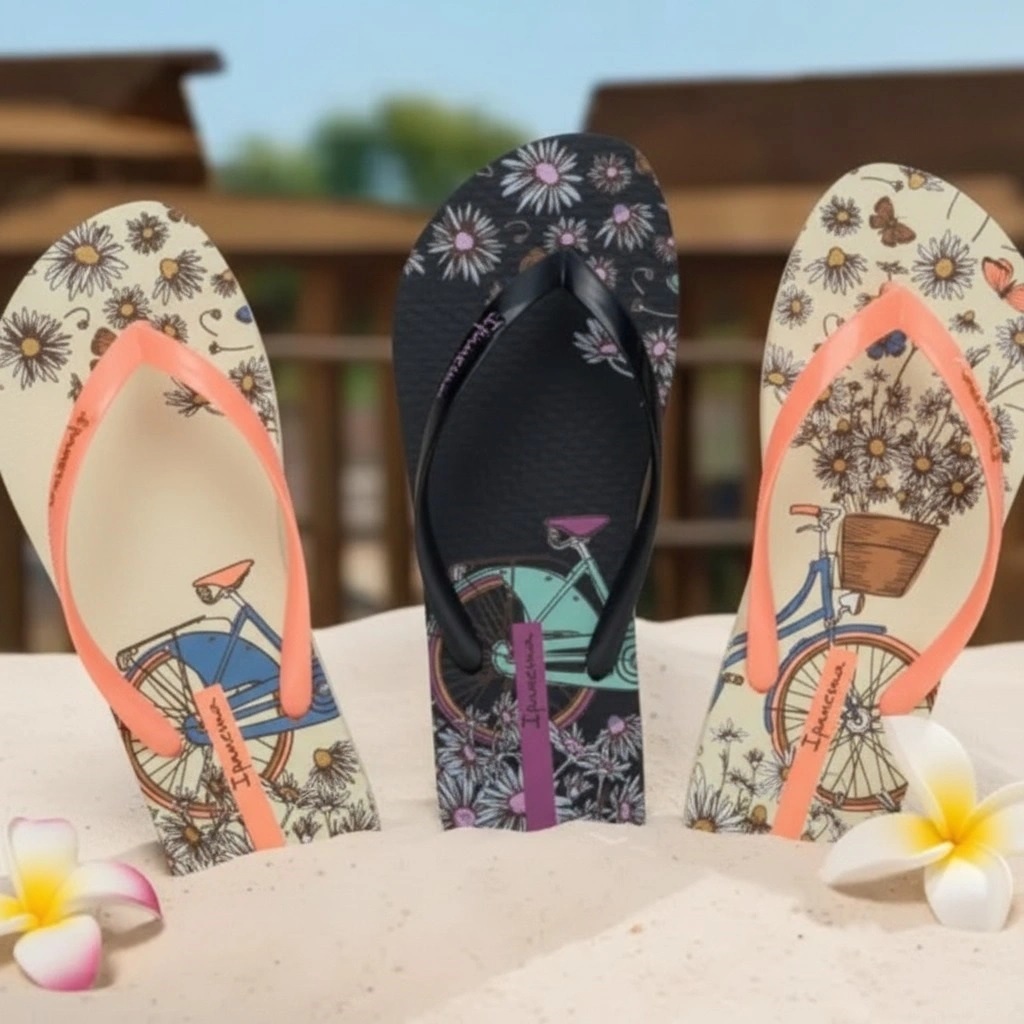Summer 2025’s arrived with a clear winner in the footwear department, and it’s not your average flip flop. Consumers worldwide are gravitating toward brands that combine style, comfort, and environmental consciousness. Ipanema flip flops have emerged as the go-to choice for beachgoers, urban explorers, and fashion enthusiasts alike, dominating retail shelves and social media feeds with their distinctive Brazilian flair.
Key Takeaways
- Ipanema’s sustainable production methods appeal to eco-conscious consumers
- Anatomic technology provides superior arch support and all-day comfort
- The 2025 collection features bold colors and designer collaborations
- Celebrity endorsements have amplified brand visibility across platforms
- Versatile designs transition seamlessly from beach settings to urban environments
The brand’s trajectory from Brazilian beach staple to global phenomenon reflects shifting consumer priorities. People aren’t just buying footwear anymore—they’re investing in products that align with their values. Ipanema’s commitment to sustainability, paired with cutting-edge design innovation, has created a perfect storm of demand that shows no signs of slowing down.
The Rise of Ipanema in the Footwear Industry
Ipanema’s journey began in 2001 as an offshoot of Grendene, Brazil’s largest footwear manufacturer. What started as a simple beach sandal line has evolved into a powerhouse brand with distribution across 100+ countries. The company’s strategic focus on combining Brazilian beach culture with modern technology set it apart from traditional flip flop manufacturers.
Market analysts attribute Ipanema’s recent surge to strategic timing. As Gen Z and Millennials prioritize sustainability and ethical manufacturing, brands that can’t demonstrate environmental responsibility are losing market share. Ipanema positioned itself perfectly by making eco-friendliness core to its identity rather than an afterthought. Their 2024 annual report showed a 43% increase in sales compared to the previous year, with projections indicating continued growth throughout 2025.
The brand’s expansion into premium retail spaces previously dominated by luxury footwear brands signals a broader shift in consumer behavior. Department stores now dedicate entire displays to Ipanema’s collections, treating them with the same reverence once reserved for high-end designer labels. This mainstreaming of sustainable fashion footwear represents a watershed moment for the industry.
What Makes Ipanema Flip Flops Unique
Sustainable Materials and Eco-Friendly Production
Ipanema’s manufacturing process utilizes 100% recyclable PVC materials that don’t compromise durability or aesthetics. Unlike petroleum-based plastics used by competitors, their proprietary material reduces environmental impact while maintaining the flexibility and resilience customers expect. The company’s facilities operate on renewable energy sources, and they’ve committed to achieving complete carbon neutrality by 2027.
The brand’s “Made from Recyclable Materials” labeling isn’t just marketing speak. Each pair of flip flops can be returned to authorized retailers for recycling, where they’re transformed into new products. This closed-loop system represents a genuine circular economy approach that’s rare in the footwear industry. Third-party environmental audits have verified Ipanema’s claims, giving consumers confidence in their purchase decisions.
Anatomic Technology for Maximum Comfort
Ipanema’s anatomic footbed technology changed the game for casual footwear. Traditional flip flops offer minimal arch support, leading to foot fatigue and potential long-term issues. Ipanema’s ergonomic design features contoured footbeds that mirror the natural shape of feet, distributing weight evenly and reducing pressure points. Podiatrists have praised this innovation, noting significant improvements over conventional designs.

The straps incorporate soft-touch materials that prevent chafing and blisters, even during extended wear. Memory foam elements in premium lines mold to individual foot shapes over time, creating a custom fit without the custom price tag. Athletes and fitness enthusiasts have discovered that Ipanema flip flops provide adequate recovery footwear post-workout, expanding their use beyond casual occasions.
Fashion-Forward Designs
Ipanema collaborates with Brazilian fashion houses and international designers to create limited-edition collections that blur the line between beach wear and high fashion. The 2025 summer collection features metallic finishes, botanical prints, and texture combinations that wouldn’t look out of place on runways. This design philosophy attracts fashion-conscious consumers who refuse to sacrifice style for comfort.
The brand releases new colorways quarterly, keeping their offerings fresh and encouraging repeat purchases. Social media-driven “drop culture” has embraced Ipanema, with certain limited editions selling out within hours of release. This scarcity marketing approach, typically associated with sneaker culture, has successfully translated to flip flops.
The 2025 Summer Collection That’s Turning Heads
Vibrant Color Palettes
This year’s palette draws inspiration from Brazil’s Amazon rainforest and coastal ecosystems. Deep emerald greens, electric blues, and sunset oranges dominate the collection, offering alternatives to the pastels and neutrals that typically define summer footwear. Color-blocking techniques create visual interest without overwhelming designs, appealing to minimalists and maximalists alike.
Gradient effects achieved through innovative molding processes give each pair unique characteristics. No two pairs look identical due to the manufacturing technique, adding an artisanal quality to mass-produced items. Customers appreciate this element of individuality in an era of cookie-cutter products.
Collaborations with Top Designers
Ipanema’s partnership with renowned designer Alexandre Herchcovitch produced a capsule collection that sold out globally within 48 hours. The collaboration featured architectural elements and geometric patterns that challenged conventional flip flop aesthetics. Fashion magazines covered the release extensively, treating it with the same attention typically reserved for luxury brand launches.
Upcoming collaborations with streetwear brands suggest Ipanema’s intention to penetrate youth culture markets more aggressively. These partnerships introduce the brand to demographics that might not traditionally consider flip flops as serious footwear choices, expanding market reach considerably.
Why Comfort Matters More Than Ever
The pandemic fundamentally altered how people view footwear comfort. Remote work normalized casual attire, and consumers who spent years in uncomfortable dress shoes aren’t eager to return to painful footwear choices. Ipanema capitalized on this shift by positioning their products as practical solutions for the new normal—comfortable enough for home offices yet presentable for video calls and outdoor activities.
Health consciousness has also influenced purchasing decisions. Consumers increasingly understand the connection between proper footwear and overall wellbeing. Ipanema’s ergonomic benefits resonate with people dealing with plantar fasciitis, flat feet, or general foot pain. Medical professionals recommend the brand, lending credibility that marketing campaigns alone couldn’t achieve.
The rise of wellness culture emphasizes holistic health approaches, where every product choice contributes to overall quality of life. Flip flops that support natural foot alignment while looking stylish fit perfectly into this philosophy. Ipanema’s messaging successfully connects their products to broader lifestyle aspirations rather than positioning them as merely functional items.
Sustainability: The Driving Force Behind Consumer Choices
Recyclable Materials
Environmental concerns dominate consumer decision-making in 2025, particularly among younger shoppers who’ll live with climate change consequences longest. Ipanema’s transparent sourcing and manufacturing practices appeal to this demographic’s demand for accountability. The company publishes detailed sustainability reports showing measurable progress toward environmental goals.
Traditional flip flop manufacturers contribute to landfill waste, with billions of pairs discarded annually. Ipanema’s recyclable materials directly address this problem, allowing environmentally conscious consumers to enjoy disposable fashion elements without guilt. The brand’s recycling program incentivizes returns through discount codes for future purchases, creating a virtuous cycle.
Carbon-Neutral Manufacturing
Ipanema’s Brazilian facilities operate entirely on hydroelectric and solar power, eliminating fossil fuel dependency from production processes. The company offsets transportation emissions through verified carbon credit programs, achieving net-zero carbon footprints. These efforts aren’t greenwashing—independent organizations regularly audit and verify claims.
Supply chain transparency extends to raw material sourcing, with detailed documentation showing ethical practices throughout. This level of openness builds trust with consumers who’ve become skeptical of vague environmental claims. Ipanema’s willingness to share specific metrics and invite scrutiny demonstrates genuine commitment rather than marketing opportunism.
Celebrity Endorsements and Social Media Buzz
A-list celebrities posting casual vacation photos wearing Ipanema flip flops created organic marketing worth millions. Influencers with combined followings exceeding 500 million regularly feature the brand, generating massive exposure. Unlike paid sponsorships that feel forced, many of these endorsements appear genuine, with celebrities purchasing products before brand partnerships materialized.
TikTok trends featuring Ipanema styling tips have accumulated billions of views, introducing the brand to Gen Z audiences. User-generated content showcasing creative ways to wear flip flops beyond beach contexts expanded perceived versatility. This grassroots enthusiasm feels authentic compared to traditional advertising, resonating more effectively with skeptical younger consumers.
Fashion bloggers praise Ipanema’s ability to elevate casual outfits without looking overdressed. The “elevated casual” trend dominating 2025 fashion relies on pieces that bridge formality gaps, and well-designed flip flops serve this purpose perfectly. Street style photographers regularly capture fashion-forward individuals wearing Ipanema, further cementing the brand’s style credentials.
Versatility: From Beach to Street Style
Pairing with Casual Outfits
Ipanema flip flops complement denim cutoffs, sundresses, and linen pants with equal ease. Their clean lines and varied designs allow for mix-and-match styling that works across different aesthetic preferences. Fashion consultants recommend keeping multiple pairs in rotation to coordinate with various color palettes and outfit moods.
The brand’s metallic and embellished options add sophistication to simple outfits, proving flip flops needn’t relegate wearers to ultra-casual categories. Fashion-forward consumers pair premium Ipanema styles with tailored shorts and designer tops, creating intentional high-low fashion statements. This styling approach challenges traditional fashion rules while remaining accessible to average consumers.
Dressy Options for Summer Events
Ipanema’s embellished collections feature crystal accents, woven details, and premium finishes suitable for garden parties and casual weddings. These dressier options fill a gap in summer footwear markets where sandals feel too casual but closed-toe shoes seem excessive. Event planners now include “dressy flip flops welcome” on invitations, acknowledging changing footwear norms.
The comfort advantage becomes particularly appealing for outdoor events where guests stand for extended periods. Hosts appreciate when guests arrive in appropriate yet comfortable footwear that won’t damage outdoor venues or sink into grass. Ipanema’s elegant designs meet these practical requirements without compromising aesthetic standards.
Durability That Justifies the Investment
Quality concerns often plague affordable footwear, but Ipanema’s construction methods ensure longevity that justifies pricing. The proprietary material resists cracking, fading, and degradation from saltwater, chlorine, or UV exposure. Customers report wearing pairs for multiple seasons without visible wear, making cost-per-wear calculations favorable compared to cheaper alternatives.
Reinforced strap attachment points prevent the common flip flop failure mode where straps pull free from soles. This engineering attention to detail demonstrates Ipanema’s commitment to product quality over planned obsolescence. Warranty policies covering manufacturing defects provide additional confidence, though claims remain rare due to robust construction.
The brand’s reputation for durability encourages higher initial investments from consumers tired of replacing cheap flip flops seasonally. Word-of-mouth recommendations emphasizing longevity drive repeat purchases and brand loyalty. Customer forums feature testimonials from users wearing the same pairs for years, validating durability claims.
Affordability Without Compromising Quality
Ipanema’s pricing strategy positions products between disposable beach flip flops and luxury sandals, occupying a sweet spot that maximizes market appeal. Most styles retail between $20-40, making them accessible without feeling cheap. This pricing attracts middle-class consumers seeking quality without luxury price tags.
Frequent sales and promotional events make the brand even more accessible, though full-price purchases remain common due to new release desirability. Retailers report strong sell-through rates at regular prices, indicating consumers perceive fair value. The combination of quality materials, attractive designs, and reasonable pricing creates compelling value propositions.
Comparison shopping reveals Ipanema offers superior specifications at comparable price points to mass-market competitors. The sustainable materials and ergonomic technology typically command premium pricing, making Ipanema’s affordability remarkable. This value equation resonates particularly well with budget-conscious environmentalists unwilling to compromise principles for price.
How Ipanema Compares to Competitors
Traditional flip flop giants like Havaianas face serious competition from Ipanema’s innovation-focused approach. While Havaianas built brand recognition through decades of consistent products, Ipanema’s rapid evolution keeps them relevant to changing consumer preferences. Side-by-side comparisons show Ipanema’s superior arch support and modern aesthetics appeal to younger demographics.
Athletic brands’ flip flop offerings emphasize performance features but often sacrifice style. Ipanema successfully balances technical specifications with fashion appeal, avoiding the “dad sandal” stigma plaguing functional footwear. This balanced approach attracts consumers unwilling to choose between comfort and appearance.
Luxury fashion houses produce expensive flip flops trading primarily on brand prestige rather than functional superiority. Ipanema’s quality approaches luxury levels at fraction of prices, appealing to value-conscious shoppers. The brand proves premium experiences needn’t require premium prices, democratizing access to well-designed footwear.
Customer Reviews and Testimonials
Online reviews consistently praise Ipanema’s comfort during extended wear periods. Customers report walking miles in flip flops without discomfort—experiences previously unimaginable with conventional designs. These testimonials address primary objections preventing flip flop adoption for activities beyond beach visits.
Sustainability-focused reviews highlight the recyclable materials and ethical manufacturing as deciding factors. Environmentally conscious consumers express satisfaction finding products aligning with values without sacrificing style or function. This feedback confirms market demand for genuinely sustainable options rather than greenwashed alternatives.
Negative reviews remain rare but typically address sizing inconsistencies between styles. Ipanema’s response to criticism demonstrates customer service commitment, often replacing products and soliciting feedback to improve future releases. This responsive approach builds brand loyalty beyond initial purchases.
Where to Buy Authentic Ipanema Flip Flops
Official brand websites offer complete selections with detailed sizing guides and customer service support. Authorized retailers include major department stores, specialty footwear shops, and select boutiques emphasizing sustainable products. Online marketplaces require caution, as counterfeit products occasionally appear despite enforcement efforts.
Physical retail allows customers to assess fit and quality before purchasing, important considerations for first-time buyers. Sales associates at authorized retailers receive brand training, providing informed assistance with sizing and style selection. In-store experiences complement online convenience, offering options for different shopping preferences.
International availability continues expanding, with distribution reaching smaller markets throughout 2025. The brand’s website features store locators helping customers find nearby retailers. Direct-to-consumer sales through official channels ensure authenticity while offering broadest selection access.
The Ipanema Phenomenon Continues
Ipanema’s dominance in summer 2025 reflects broader trends reshaping consumer goods industries. Brands demonstrating authentic commitment to sustainability while delivering superior products will continue capturing market share from traditional competitors. Ipanema’s success proves consumers will enthusiastically support companies aligning profit motives with environmental responsibility.
The flip flop category’s transformation from disposable beach accessories to legitimate fashion footwear highlights evolving consumer sophistication. People increasingly recognize false dichotomies between style, comfort, and sustainability—demanding products delivering all three. Ipanema’s ability to meet these expectations positions them for continued growth beyond current success.
As summer 2025 progresses, Ipanema flip flops’ cultural impact extends beyond footwear trends into broader conversations about conscious consumption and accessible sustainability. The brand’s trajectory suggests that doing good and doing well aren’t mutually exclusive, offering hope that market forces can drive positive environmental change when companies genuinely commit to principles beyond profit maximization.
Are Ipanema flip flops worth the price compared to cheaper alternatives?
Yes, Ipanema flip flops justify their pricing through superior durability, ergonomic design, and sustainable materials. While initial costs exceed basic options, longevity and comfort make cost-per-wear calculations favorable. Customers report multiple seasons of use without degradation, unlike cheaper alternatives requiring frequent replacement.
Can I wear Ipanema flip flops for walking long distances?
Ipanema’s anatomic footbed technology provides adequate support for extended walking, though individual tolerance varies. Many customers comfortably walk several miles in their flip flops, citing superior arch support compared to traditional designs. However, athletic shoes remain better choices for serious hiking or intensive physical activities.
How do I participate in Ipanema’s recycling program?
Visit the brand’s official website to locate participating retailers accepting used flip flops for recycling. Clean your worn pairs and bring them to designated drop-off locations, where you’ll typically receive discount codes for future purchases. The program accepts any brand’s flip flops, not just Ipanema products, demonstrating broader environmental commitment.


